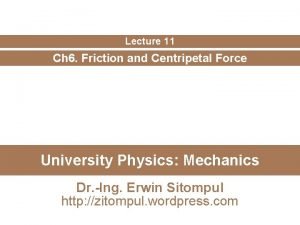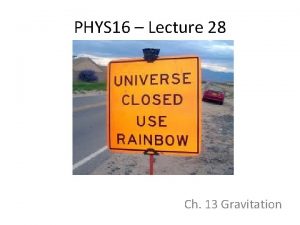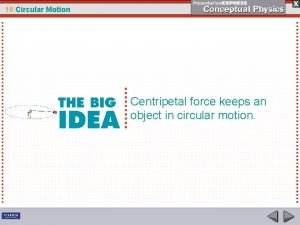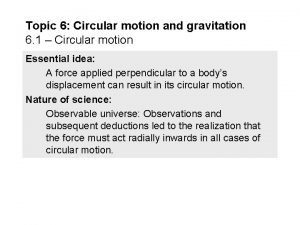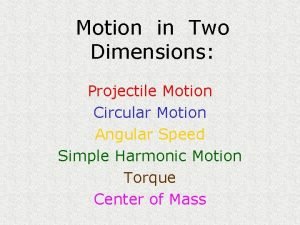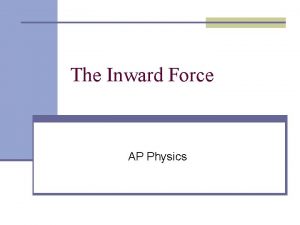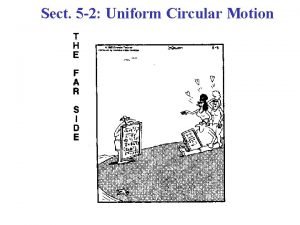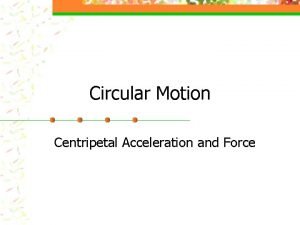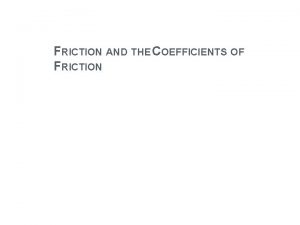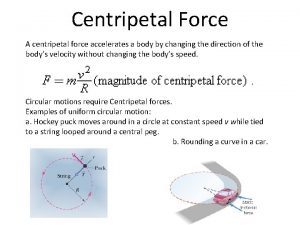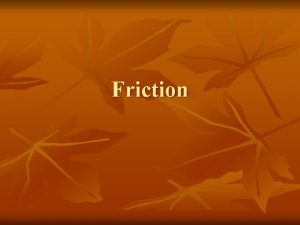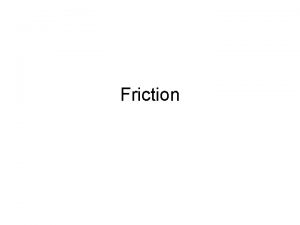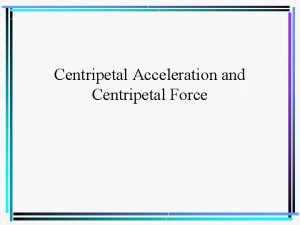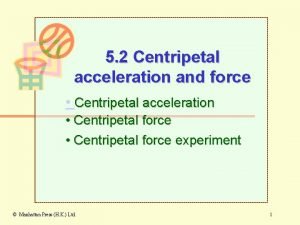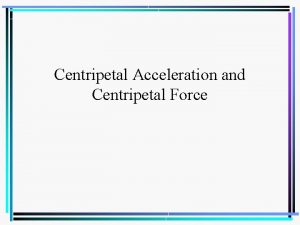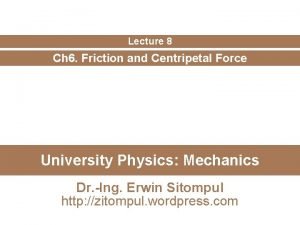Lecture 11 Ch 6 Friction and Centripetal Force















- Slides: 15

Lecture 11 Ch 6. Friction and Centripetal Force University Physics: Mechanics Dr. -Ing. Erwin Sitompul http: //zitompul. wordpress. com

Uniform Circular Motion § Let us recall that when a body moves in a circle (or a circular arc) with the radius R at constant speed v, it is said to be in uniform circular motion. § The body has a centripetal acceleration (directed toward the center of the circle) of constant magnitude given by: (centripetal acceleration) § As shown here, a hockey puck moves around in a circle at constant speed v while tied to a string looped around a central peg. § The centripetal force is the radially → inward pull T on the puck from the string. § Without that force, the puck would slide off in a straight line instead of moving in a circle. Erwin Sitompul University Physics: Mechanics 11/2

Uniform Circular Motion § From Newton’s second law, we can write the magnitude F of a centripetal force as: (magnitude of centripetal force) § Because the speed v is constant, the magnitudes of the acceleration and the force are also constant. § However, the directions of the centripetal acceleration and force are not constant; they vary continuously and always point toward the center of the circle (radially inward). § The positive direction of the axis is chosen to be radially outward. Erwin Sitompul University Physics: Mechanics 11/3

Checkpoint When you ride in a Ferris wheel at constant speed, what are the directions of your → → acceleration a and the normal force FN on you (from the upright seat) as you pass through (a) the highest point of the ride? (b) the lowest point of the ride? • The highest point → → a downward, FN upward • The lowest point → → a and FN upward Erwin Sitompul University Physics: Mechanics 11/4

Example: “Allo Diavolo” In a 1901 circus performance, “Allo Diavolo“ introduced the stunt of riding a bicycle in a loop-the-loop. Assuming that the loop is a circle with radius R = 2. 7 m, what is the least speed v Diavolo could have at the top of the loop to remain in contact with it there? • By the time Diavolo remain in contact with the loop, FN = 0. Erwin Sitompul University Physics: Mechanics 11/5

Example: Riding the Rotor A Rotor is a large, hollow cylinder that is rotated rapidly around its central axis. When the rider’s speed reaches some predetermined value, the floor abruptly falls away. The rider does not fall with it but instead is pinned to the wall while the cylinder rotates. Suppose that the coefficient of static friction μs between the rider’s clothing and the wall is 0. 40 and that the cylinder’s radius R is 2. 1 m. Erwin Sitompul University Physics: Mechanics 11/6

Example: Riding the Rotor (a) What minimum speed v must the cylinder and rider have if the rider is not to fall when the floor drops? (R = 2. 1 m) • Vertical calculations • Radial calculations Erwin Sitompul University Physics: Mechanics 11/7

Example: Riding the Rotor (b) If the rider’s mass is 49 kg, what is the magnitude of the centripetal force on her? If the Rotor initially moves at the minimum required speed for the rider not to fall (7. 173 m/s) and then its speed is increased step by step, what will happen with (a)→the magnitude of fs; (b) → the magnitude of FN; (c) the value of fs, max? Increase, → decrease, or remain the same? Erwin Sitompul University Physics: Mechanics 11/8

Example: F 1 Car A modern F 1 car is designed so that the passing air pushes down on it, allowing the car to travel much faster through a flat turn in a Grand Prix without friction failing. This downward push is called negative lift or down force. The following figure represents an F 1 car of mass m = 600 kg as it travels on a flat track in a circular arc of radius R = 100 m. Because of the shape of→the car and the wings on it, the passing air exerts a negative lift FL downward on the car. Take μs = 0. 75 and assume that the forces on the four tires are identical. Negative lift exerted by passing air Erwin Sitompul University Physics: Mechanics 11/9

Example: F 1 Car (a) If the car is on the verge of sliding out of the turn when its speed is 28. 6 m/s, what → is the magnitude of FL? • Vertical calculations • Radial calculations Free body diagram for the car • On the verge of sliding Erwin Sitompul University Physics: Mechanics 11/10

Example: F 1 Car (b) The magnitude FL of the negative lift on the car depends on the square of the car’s speed v 2. Thus, the negative lift on the car here is greater when the car travels faster, as it does on a straight section of track. What is the magnitude of the negative lift for a speed of 90 m/s? • By the time the speed is 90 m/s, the negative lift is already greater than the gravitational force. • Thus, the car “could have” run on a long ceiling with that velocity (324 km/h). Erwin Sitompul University Physics: Mechanics 11/11

Example: Banked Curved Highways Curved portions of highways are always banked to prevent cars from sliding off the highway. When the highway is wet, the frictional force maybe significantly low, and banking is then essential. The figure below represents a normal car of mass m as it moves at a constant speed v of 20 m/s around a banked circular track of radius R = 190 m. If the frictional force from the track is negligible, what bank angle θ prevents sliding? Erwin Sitompul University Physics: Mechanics 11/12

Example: Banked Curved Highways • Vertical calculations • Radial calculations Erwin Sitompul University Physics: Mechanics 11/13

A Puck on A Table A puck of mass m = 1. 5 kg slides in a circle of radius r = 20 cm on a frictionless table while attached to a hanging cylinder of mass M = 2. 5 kg by a cord through a hole in the table. What speed keeps the cylinder at rest? • Answer: v = 1. 81 m/s Erwin Sitompul University Physics: Mechanics 11/14

Homework 10 New Driving in a car with a constant speed of 12 m/s, a driver encounters a bump in the road that has a circular cross-section, as shown in the figure above. a) If the radius of the curvature of the bum is 35 m, find the apparent weight of the 70 -kg driver as he passes over the top of the bump. b) At what speed must the driver go over the bump until he feel “weightless”? Erwin Sitompul University Physics: Mechanics 11/15
 Centripetal acceleration formula
Centripetal acceleration formula Friction and centripetal force
Friction and centripetal force Centripetal force and gravitational force
Centripetal force and gravitational force Which arrow below represents the direction of acceleration
Which arrow below represents the direction of acceleration What force provides centripetal force
What force provides centripetal force Centripetal force vs centrifugal
Centripetal force vs centrifugal Air resistance contact or non contact
Air resistance contact or non contact 6-1 centripetal acceleration and force
6-1 centripetal acceleration and force 6-1 centripetal acceleration and force
6-1 centripetal acceleration and force Ali is climbing where does he need high friction
Ali is climbing where does he need high friction Example of centripetal force ap human geography
Example of centripetal force ap human geography Normal force at top of loop
Normal force at top of loop What type of quantity is centripetal acceleration?
What type of quantity is centripetal acceleration? Ap physics centripetal force
Ap physics centripetal force Circular motion with constant speed
Circular motion with constant speed Missy's favorite ride at the topsfield fair is the rotor
Missy's favorite ride at the topsfield fair is the rotor

